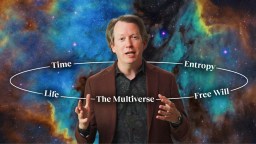Where there is water, there is life—and Europa’s got water alright: scientists believe it has twice the volume of Earth’s oceans swirling beneath its kilometers-thick ice crust. A moon in Jupiter’s massive orbit, Europa has captivated astrophysicists, including Neil deGrasse Tyson, because it has completely blown open the borders in the search for life in our universe. Europa is well outside of the life-supporting “Goldilocks Zone”. Tyson explains how liquid water can exist in such a frozen part of our solar system, and how engineers might approach getting through all that ice to potentially come face to face/membrane with life, whether simple or complex. It won’t be too long before NASA’s ‘Europa Clipper’ mission makes its move to investigate the habitability of the icy moon: it will head for Europa in the 2020s. Tyson’s new book is Astrophysics for People in a Hurry.
Neil deGrasse Tyson: Nobody doesn't love Europa. Let me back up.
When we think of places you might find life we typically think of the Goldilocks zone around a star where water would be liquid in its natural state, and if you get a little too close to the star heat would evaporate the water and you don't have it anymore, it's gone. Too far away, it would freeze and neither of those states of H2O are useful to life as we know it. We need liquid water. So you can establish this green zone, this habitable zone, this Goldilocks zone where if you find a planet orbiting there: hey, good chance it could have liquid water. Let's look there first for life as we know it.
Now, it turns out that this source of heat, of course, is traceable to the sun, and if you go farther out everything would or should be frozen, all other things being equal. But Europa, a moon of Jupiter sitting well outside of the Goldilocks zone, is kept warm. Not from energy sources traceable to the sun, but from what we call the tidal forces of Jupiter itself.
So Jupiter and surrounding moons are actually pumping energy into Europa. And how does it do that? As Europa orbits Jupiter its shape changes. It's not fundamentally different from tides rising and falling on Earth. The shape of the water system of the earth is responding to tidal forces of the moon and when you do that to a solid object, the solid object is stressing and because of this, a consequence of this is that you are pumping energy into the object.
It is no different from when you say—anyone who's familiar with racquet sports, indoor racquet sports, it could be racquetball or squash—you say, “Let's warm up the ball before we start playing.” You want to hit it around a few times. You are literally warming up the ball. It's not just simply, “Let's get loose,” it’s, you are literally warming up the ball. How? You are distorting it every time you smack it and then the resilience of the ball pops it back into shape, and every time you do that, every smack, you're pumping energy into the ball. That's not fundamentally different from what's going on in orbit around Jupiter.
So you have this frozen world Europa, completely frozen on its surface, but you look at the surface and there are cracks in the ice. There are ridges in the ice where there's a crack and it's shifted and then re-froze. So this ridge has a discontinuity in the crack and it continues in another place. So what this tells you is that Europa cannot be completely frozen because if it were nothing would be moving.
You look at the surface of Europa, the frozen surface, there are like ice chunks that are like shifted and re-frozen and shifted again. It looks just like if you fly over the Arctic Ocean. Fly over the Arctic Ocean in the winter, these are ice sheets that are breaking and re-freezing all the time. It's the same signature as that.
So all of us are convinced that beneath this icy surface is an ocean of liquid water and there's no reason to think it wouldn’t have been liquid for billions of years. On Earth, where we find liquid water we find life. Wherever we find liquid water we find life.Even places like the Dead Sea—why did anybody call it a Dead Sea? Because the microscope hadn't yet been invented. And sure maybe there's no macroscopic vertebrate fishes, but microbes have no problems thriving in practically any condition under which you would find liquid water.
So what this means is, not only do we have a source of heat outside of the Goldilocks zone, we have conditions under which life could be thriving, and knowing that this is possible has completely broadened the net that we are casting in search for life in the universe. No longer is it: “Let's find a 72-degree tidal pond and see life forming there." No, life is pretty hardy and if it takes liquid water that may be the other place in the solar system that is teeming with some form or another of life.
So, yeah, we all want to go to Europa, period. We’ve got to go ice fishing though, because you've got to cut a hole or melt a hole, you’ve got to get there somehow because the sheet of ice by some estimates are several kilometers thick, and so it will take some effort to get through that, which we haven't really fully figured out yet. But it's an engineering problem not a science problem. So a clever engineer should be able to figure that one out.
And by the way, Europa is not the only one of these moons in the outer solar system that is kept warm by these sort of tidal stress forces, there are other moons that feel the same influx of energy. So for example, Io, that's the innermost moon of Jupiter, that suffers from this phenomenon even more. And that moon is so hot there are volcanoes erupting from within. It is rendered molten, whatever solid parts of that moon there are, and so in fact the most volcanically active place in the solar system is Io, one of the moons of Jupiter. And we don't know how to sustain life under temperatures that hot, but it's a reminder that if you're looking for sources of energy we no longer need to be anchored to a host star in our search for life in the universe.







